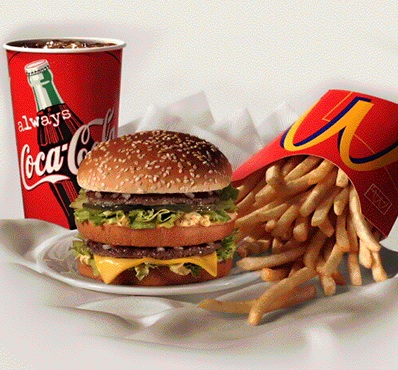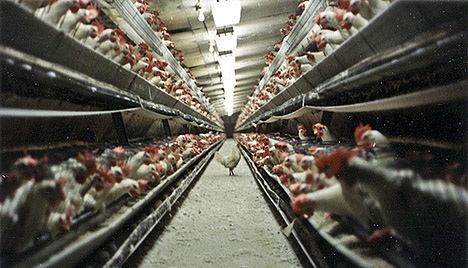

I originally picked the meat industry as my final project topic because the centralized, industrialized factory farming and feedlot system’s negative effect on the environment boldly underlines a strong relationship between technology and the environment. Knowing that this topic has several different dimensions to it, I decided to pick a wide breadth of articles. What came as a refreshing surprise, however, was the classes’ willingness to focus on the cultural dimensions of meat eating and consumption (which, of course, links to the theme of “human nature”).
Almost all of the articles for discussion focused on not only the negative effects of meat production but also that of meat consumption: As Jim Motavalli points out in “The Meat of the Matter,” meat consumption has doubled in just fifty years. Everyone appeared to agree on the fact that eating meat, through its easy availability and cheap prices (just think of McDonald’s), has become cemented into our culture’s diet. I pointed out that there are health consequences to eating meat, from the microbes that have been linked to factory farm production to the fact that Americans (and, even, the rest of the world) are over-consuming a type of food that, frankly, is not healthy at all (heart disease, after all, is the number one killer in America). In not appearing surprised by these statistics, some people in the class argued that it really isn’t the primary interest of Americans today to keep these facts in mind. There is a certain level of denial, then. While Jonathon Safran Foer in his NPR interview displays frustration that Americans cannot really see factory farms, the class aptly responded that meat consumers would rather not see these farms and know the problems associated with them—as the saying goes, ignorance is bliss. Our culture, moreover, is so rushed and so hurried that many Americans would rather not spend the extra effort (or money) to buy organic, locally grown or slaughtered food. Furthermore, Americans resist the idea of cutting out meat because it has become so commonplace in culture, from grocery stores to national and religious celebrations.

Like any problem, it is important to not just discuss the implications of the problem but also solutions that can go about resolving it. Michael Pollan’s New York Times Magazine article “Farmer in Chief” served as an important launching point for discussion because the article, which is addressed to then-President-Elect Barack Obama, calls for the country to “rebuild” its food industry. Pollan claims early on that food is of outmost importance for the nation—from national issues of health and national security to moral notions of environmental degradation and animal rights. Under Pollan’s view, our country needs to reach a point of environmental and economic sustainability that can only be achieved through “resolarizing,” “reregionalizing,” and “rebuilding” our food society. Some people were skeptical that Pollan’s idealistic suggestions could be put into practice. For instance, many noted that for people to make a change there needs to be some self-evident benefit. This could come in many forms. During the strife of World War II, for example, 40% of the nation’s food came from family gardens called “Victory Gardens.” In this case, Tommy mentioned that there was a common national goal through the war. Maggie proposed that there could be some form of tax breaks or benefits for people who consumed more sustainable food. In speaking of the government, the class focused briefly on how our government, through subsidies on grain, deregulation of waste, and approval of antibiotic treatment, actually endorses Confined Animal Feeding Operations (CAFOs, or factory farms). The John Hopkins study, even, argued that small farmers have been pushed out of business and presented statistics showing there are very few farms for how many animals are being slaughtered daily. While there was some skepticism about Pollan’s account, Professor Everbach pointed out the importance of cultural positive feedback loops: If sustainable ways of eating catch on in a regional basis, they can potentially reach a national tipping point of irrevocable—though, in this case, positive—change. Michael mentioned the importance of making “conscious choices” with food, one of which might simply be reducing consumption of factory-farmed food.
When discussing meat, it goes without saying that the use of antibiotics in factory-farmed meat is a vital topic, which Laura Sayre’s “The Hidden Link Between Farms and Human Illnesses” touches on. Within the scope of this course, Sayre’s article connected back to Jared Diamond’s idea that human germs and microbes were brought about through close interaction with animals. Tommy presented a solid summary of Sayre’s account, which argues that 70% of antibiotics are used today in meat. As these antibiotics are used to get rid of germs, this use ironically brings about newer, more dangerous microbes that become immune to antibiotic treatment and, consequently, cannot be adequately addressed through modern medicine. Of all the points, many people in the class seemed most disturbed by these facts. With outbreaks (such as E. coli and salmonella, and even the scare over mad cow disease), many people argued that today’s society is too obsessed with solving the short-term problem of an outbreak rather than the long-term problem of the system itself. In other words, outbreaks are perceived as being isolated incidents instead of problems symptomatic of a larger, unhealthier system of production. Many people brought up the idea of a “tech fix” because society has, potentially, too much faith in this form of production, which is advanced yet undoubtedly dangerous.
Due to time, we were not able to touch too much on the meat industry’s (or, more generally, the food industry’s) negative effects on the environment. What’s most important to glean from this focus on environmental degradation—which is addressed in the FAO’s “Livestock a major threat to environment,” Jim Matavalli’s “Meat of the Matter,” the John Hopkins report, and all the other short articles—is that meat production causes soil erosion, water pollution, and deforestation and creates more greenhouse gas emissions than transportation. While this area would have seemed interesting for tying together technology and the environment, people seemed to understand these points. I was glad, however, that people were excited to talk about the cultural dimensions of this debate since this is the part that they, through individual actions, can change to address this problem.
Pieces Used for Presentation
PDFs
Horrigan, Leo, Robert S. Lawrence, and Polly Walker. "How Sustainable Agriculture Can Address the Environmental and Human Health Harms of Industrial Agriculture." Johns Hopkins Bloomberg School of Public Health. Research Review. Environmental Health Perspectives. Volume 110, Number 5. May 2002.
Matavalli, "Meat of the Matter." E: The Environmental Magazine. Jul/Aug 2008. 27-33.
Sayre, Laura. "The Hidden Link Between Factory Farms and Human Illness." Mother Nature Earth. Feb/Mar 2009. 76-83.
Digital Files
Jonathon Safran Foer Interview. NPR. http://www.npr.org/templates/story/story.php?storyId=114298495
Trailer for Food, Inc. http://www.youtube.com/watch?v=5eKYyD14d_0.
Clip from Food, Inc. http://www.youtube.com/watch?v=BCJ79HWTRHM.
Drawn from the famous documentary, these clips present actual images to this issue.
Online Articles
Baker, Stanely. "Factory farms - the only answer to our growing appetite?" The Guardian. 1964. http://century.guardian.co.uk/1960-1969/Story/0,,105655,00.html.
This article was meant to illustrate that factory farms were beginning to be on the rise in the 1960s.
"Livestock a major threat to environment." FAO. 2006. http://www.fao.org/newsroom/en/news/2006/1000448/index.html.
This article, pulling from the Food and Agriculture Organization, makes important claims about meat production. In addition to listing environnmental consequences of meat production and consumption, this article says that meat consumption has increased greatly over the past 50 years and, consequently, has contributed greatly to worldwide greenhouse gas levels.
"Livestock Emissions: Still Grossly Underestimated?" World Watch Institute. 2009. http://www.worldwatch.org/node/6297.
While the FAO's report claims that the livestock sector generates 18% of worldwide greenhouse gas, this article claims that this value might be actually be as high as 51%.
Niman, Nicolette Hahn. "The Carnivore's Dilemma." The New York Times. 2009. http://www.nytimes.com/2009/10/31/opinion/31niman.html?pagewanted=all.
Hahn contends that meat is not an inherently unhealthy or damaging kind of food as long as it is produced in a sustainable way.
Pollan, Michael. "Farmer in Chief." New York Times Magazine. 2008. http://www.nytimes.com/2008/10/12/magazine/12policy-t.html?pagewanted=print.
"U.S. could feed 800 million people with grain that livestock eat, Cornell ecologist advises animal scientists." Cornell University. 1997. http://www.news.cornell.edu/releases/Aug97/livestock.hrs.html.
As the title states, the amount of land and food that is need to feed "our food" has gotten to astronomical levels.
Optional
Pollan, Michael. "Why Bother?" The New York Times. 2008. http://www.nytimes.com/2008/04/20/magazine/20wwln-lede-t.html?_r=1&pagewanted=print.
Pollan claims that people, in aiming for a seemingly unrealistic future of healthy, sustainable food, should look at their personal, day-to-day decisions as major factors in future change.
Send message to Swarthmore College Environmental Studies
last updated 4/12/10
webmaster